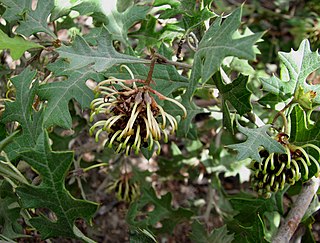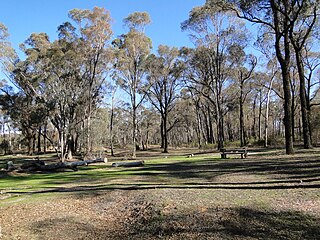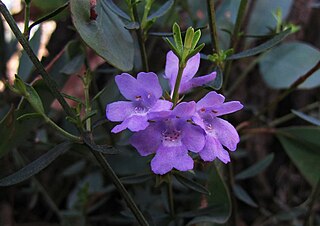
The Chiltern-Mt Pilot National Park is a national park that is located in the Hume region of Victoria, Australia. The 21,650-hectare (53,500-acre) national park is situated approximately 275 kilometres (171 mi) northeast of Melbourne, and extends west from Beechworth across the Hume Freeway and the Albury-Melbourne railway line to the west of Chiltern.
The Morwell National Park is a national park located in the western Gippsland region of Victoria, Australia. The 565-hectare (1,400-acre) national park is situated approximately 164 kilometres (102 mi) east of Melbourne via the Princes Highway and 16 kilometres (9.9 mi) south of Morwell in the Strzelecki Ranges. The park preserves a remnant of previously widespread wet sclerophyll forests and some rainforest remnants restricted to deep creek gullies. 320 plant species have been recorded for this park, including five rare or threatened species and 44 orchid species. 129 native fauna species have been recorded, including 19 mammals, 96 birds, 11 reptiles and three amphibians.

Yarra Ranges National Park is located in the Central Highlands of Australia's southeastern state, Victoria, roughly 107 km northeast of Melbourne. Established in 1995, and managed by the statutory authority Parks Victoria, the park features a carbon-rich, temperate rainforest as well as a subalpine, eucalypt-dominant forest on its northern plateau. The park is home to large groves of mountain ash, the tallest species of tree in Australia, and among the tallest in the world, with specimens reaching 80 metres in height. A wide diversity of flora, fauna and fungi make their home across the park's 76,003 hectares, including iconic Australian species such as bandicoots, echidnas, kangaroos, koalas, platypuses, possums, sugar and greater gliders, wallabies and wombats. There are nearly 200 documented species of birds in the area, with at least 60 herpetofaunal species, thousands of invertebrates and worms, over 900 types of fungi and mushrooms, and over 1,000 plant species. Among the conservation challenges facing Yarra Ranges National Park are climate change and invasive species of weeds, as well as the interaction of native species with non-native, introduced invasive animals, such as European hares and rabbits, domestic sheep, feral cats and dogs, red foxes, South Asian sambar deer, and European red and fallow deer.

Archibald James Campbell was an Australian civil servant in the Victorian government Customs Service. However, his international reputation rests on his expertise as an amateur ornithologist, naturalist, and photographer.

The Field Naturalists Club of Victoria (FNCV) is an Australian natural history and conservation organisation. The club is the oldest of its kind in Australia and is unique in having existed continuously since its foundation. Since its founding, the club has drawn its membership from the ranks of both amateur naturalists and professional scientists. This dual stream of members has continued into the 21st century, in which the club is well known for not only its scientific research output, but also numerous ongoing citizen science projects.

The Dryandra Woodland National Park is a national park in Western Australia within the shires of Cuballing, Williams and Wandering, about 164 kilometres south-east of Perth and 22 kilometres north-west of the town of Narrogin. It is a complex of 17 distinct blocks managed by the Western Australian Department of Biodiversity, Conservation and Attractions and spread over approximately 50 kilometres separated by areas of agricultural land. The area is considered to be one of the state's major conservation areas, and although it is far from pristine due to its history of logging operations, a number of species of threatened fauna are rebuilding populations through the removal of introduced predators such as foxes and feral cats.

The Cathedral Range State Park located in Victoria, Australia, approximately 100 kilometres (62 mi) north-east of Melbourne. It is situated between the towns of Buxton and Taggerty and runs parallel to the Maroondah Highway. The Cathedral Range was declared a State Park on 26 April 1979. It consists of 3,577 hectares and contains the rugged Razorback and spectacular peaks of the Cathedral Range, Little River and forested hills of the Blue Range. Due to its proximity to Melbourne the Cathedral Ranges are a popular destination for both day and weekend adventures. Bushwalking, camping, rock climbing and abseiling are some of the more popular activities available. Cathedral Range State Park is listed as Category II under the IUCN World Commission on Protected Areas and is an example of a park that can be used for recreation, education and conserving natural ecosystems.

The red-chested buttonquail is a species of bird in the family Turnicidae. It is endemic to Australia. The species is generally regarded as widespread, although uncommon, in New South Wales, Queensland, northern Western Australia and the Northern Territory, and classified as Vulnerable in Victoria.

The Geelong Field Naturalists Club (GFNC) is an Australian regional amateur scientific natural history and conservation society which was originally founded in the 1890s and re-established in 1961 in its present form. It is based in Geelong, Victoria, with the aims of preserving and protecting native flora and fauna, promoting the conservation of natural resources and the protection of endangered species and habitats, and recording information and knowledge about the flora and fauna of the Geelong region.

Grevillea dryophylla, also known as Goldfields grevillea, is a species of flowering plant in the family Proteaceae and is endemic to Victoria, Australia. It is a spreading to erect shrub with hairy branchlets, lobed leaves, and green to brown or yellow flowers.

The Goldfields region of Victoria is a region commonly used but typically defined in both historical geography and tourism geography. The region is also known as the Victorian Golden Triangle.

The Greater Bendigo National Park is a national park located in the Loddon Mallee region of Victoria, Australia. The 17,020-hectare (42,100-acre) national park was created in 2002 from the former Whipstick State Park, Kamarooka State Park, One Tree Hill Regional Park, Mandurang State Forest and the Sandhurst State Forest.

Westringia crassifolia, commonly known as whipstick westringia, is a flowering plant in the family Lamiaceae and is endemic to Victoria, Australia. It is a rare shrub with narrow leaves and lavender-purple or pink flowers in spring.

Gonocarpus montanus is a perennial, terrestrial herb in the family Haloragacae. It is native to N.S.W, Victoria, Tasmania and New Zealand. Common names include mountain raspwort and mat raspwort. Its synonym is Haloragis montana.
Whipstick is a locality in the City of Greater Bendigo in the Australian state of Victoria.
Philip Clark Ingamells was an Australian conservationist, photographer, writer and advocate for the preservation of parks and wilderness areas who worked for the Victorian National Parks Association (VNPA).
The Castlemaine Field Naturalists Club (CFNC) is an Australian regional natural history society dedicated to the study, appreciation and conservation of the natural environment in the Castlemaine region of Victoria. Founded in 1976, the CFNC has played a pivotal role in promoting environmental awareness and scientific enquiry within the Castlemaine community.
The Latrobe Valley Field Naturalists Club is an Australian regional scientific natural history and conservation society. It is based in the Latrobe Valley in Victoria and draws members from across western, central and southern Gippsland.

The Field Naturalists' Club of Ballarat (FNCB) is an Australian regional scientific natural history and conservation society. The club was founded in 1952 (a continuation of the Field Club and Science Society) and is located in Ballarat, Victoria.













